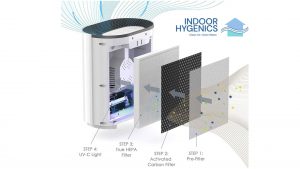Understanding the Magic of Air Purifiers: A Breath of Fresh Air
Delving Into the Inner Workings of Air Purifiers
Air purifiers have become increasingly popular in recent years as people strive to improve the quality of the air they breathe. These devices are designed to remove harmful pollutants and allergens from the air. Creating a cleaner and healthier indoor environment. But have you ever wondered how air purifiers work their magic? In this article, we’ll explore the science behind air purification and uncover the secrets behind these fascinating devices.
Filtration: The Heart and Soul of Air Purifiers
At the core of every air purifier lies a filtration system that acts as the first line of defense against airborne impurities. The most common type of filter used in air purifiers is the High-Efficiency Particulate Air (HEPA) filter. These filters are incredibly effective at capturing tiny particles, including dust, pollen, pet dander, mold spores, and even some bacteria and viruses.
HEPA filters work by using a dense web of fibers that create a maze-like structure. As air passes through the filter, these fibers trap and capture particles, preventing them from reentering the environment. The size of particles that a HEPA filter can capture is astonishingly small, as small as 0.3 microns—a human hair is about 50 microns thick! This makes HEPA filters highly efficient in removing a wide range of contaminants from the air.
The Power of Activated Carbon
While HEPA filters excel at capturing solid particles, they may not be as effective against certain gaseous pollutants and odors. To combat this, many air purifiers also include an activated carbon filter or a carbon pre-filter. Activated carbon is incredibly porous and has a large surface area, which allows it to adsorb a wide variety of gases, chemicals, and volatile organic compounds (VOCs). This helps eliminate unpleasant odors and reduces exposure to harmful pollutants such as formaldehyde and benzene.
When air passes through the activated carbon filter, the pollutants become trapped in the porous structure of the carbon. This process is known as adsorption. where the pollutants adhere to the surface of the carbon. As a result, the purified air that exits the air purifier is noticeably fresher and free from many unpleasant smells.
The Wonders of Ionization
Another technology commonly employed in air purifiers is ionization. These purifiers use an electric charge to create negative ions that attach to airborne particles. This process causes the particles to become heavy and fall out of the air, effectively removing them from the environment.
Ionizers can be either built into the air purifier or offered as a standalone unit. Some people prefer standalone ionizers as they can be placed strategically around the room to target specific areas. However, it’s important to note that some ionizers produce small amounts of ozone as a byproduct, which can be a concern for individuals with respiratory sensitivities. When choosing an ionizer, it’s crucial to select one that adheres to safety guidelines and ensures ozone levels remain within acceptable limits.
Exploring Additional Air Purification Technologies
Beyond the three primary technologies discussed above, there are other innovative air purification techniques gaining popularity. One such method is ultraviolet germicidal irradiation (UVGI), which utilizes ultraviolet (UV) light to destroy or deactivate bacteria, viruses, and other microorganisms. UVGI is often used in conjunction with filters to provide a comprehensive air purification solution.
Another emerging technology is photocatalytic oxidation (PCO), which combines UV light with a catalyst material to break down harmful pollutants at a molecular level. When UV light reacts with the catalyst, it triggers a chemical reaction that transforms pollutants into harmless byproducts, such as carbon dioxide and water vapor. PCO technology is particularly effective in eliminating volatile organic compounds (VOCs), bacteria, and even some viruses.
Additionally, some air purifiers utilize electrostatic precipitation to remove particles from the air. These purifiers have an ionizing section that charges the particles, causing them to stick to oppositely charged plates or filters. This method is especially useful for capturing larger particles like dust and pet hair.
Furthermore, advancements in air purifier technology have led to the development of smart purifiers. These devices are equipped with sensors that can detect changes in air quality, such as particulate matter levels. VOC concentrations, and humidity. Based on these measurements, the purifiers automatically adjust their settings to optimize purification and maintain healthy indoor air quality.
It’s worth noting that while air purifiers can significantly improve indoor air quality. They should not be considered a cure-all solution. They work best when combined with proper ventilation, regular cleaning, and other healthy indoor habits. It’s important to keep doors and windows closed when using air purifiers to prevent outdoor pollutants from entering the space.
Maintenance is also essential to ensure the longevity and efficiency of your air purifier. Regularly clean or replace filters according to the manufacturer’s instructions. This ensures that the purifier continues to operate at its optimal performance, capturing pollutants effectively.

